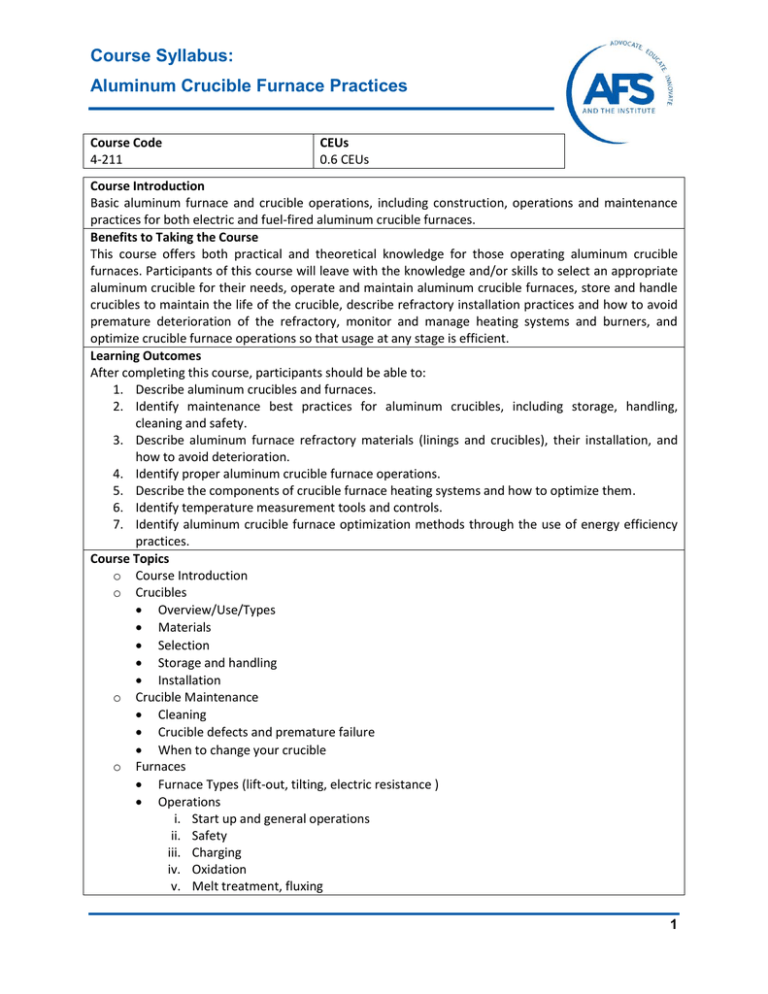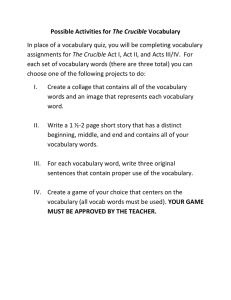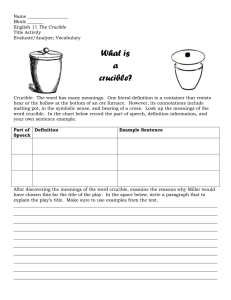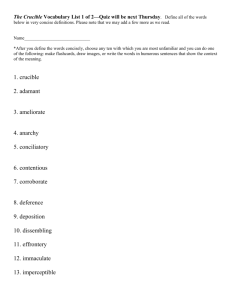Course Syllabus: Aluminum Crucible Furnace Practices
advertisement

Course Syllabus: Aluminum Crucible Furnace Practices Course Code 4-211 CEUs 0.6 CEUs Course Introduction Basic aluminum furnace and crucible operations, including construction, operations and maintenance practices for both electric and fuel-fired aluminum crucible furnaces. Benefits to Taking the Course This course offers both practical and theoretical knowledge for those operating aluminum crucible furnaces. Participants of this course will leave with the knowledge and/or skills to select an appropriate aluminum crucible for their needs, operate and maintain aluminum crucible furnaces, store and handle crucibles to maintain the life of the crucible, describe refractory installation practices and how to avoid premature deterioration of the refractory, monitor and manage heating systems and burners, and optimize crucible furnace operations so that usage at any stage is efficient. Learning Outcomes After completing this course, participants should be able to: 1. Describe aluminum crucibles and furnaces. 2. Identify maintenance best practices for aluminum crucibles, including storage, handling, cleaning and safety. 3. Describe aluminum furnace refractory materials (linings and crucibles), their installation, and how to avoid deterioration. 4. Identify proper aluminum crucible furnace operations. 5. Describe the components of crucible furnace heating systems and how to optimize them. 6. Identify temperature measurement tools and controls. 7. Identify aluminum crucible furnace optimization methods through the use of energy efficiency practices. Course Topics o Course Introduction o Crucibles Overview/Use/Types Materials Selection Storage and handling Installation o Crucible Maintenance Cleaning Crucible defects and premature failure When to change your crucible o Furnaces Furnace Types (lift-out, tilting, electric resistance ) Operations i. Start up and general operations ii. Safety iii. Charging iv. Oxidation v. Melt treatment, fluxing 1 Refractory Materials Causes of deterioration i. Thermal shock ii. Carbon deposits iii. Mechanical abuse iv. Metal penetration Replacement and Repair of Furnace Materials Electric Resistance Furnaces o Heating systems Types (Fuel fired, Recuperation, Electric Resistance) Combustion by-products and control methods Emissions and environmental regulations Optimizing burner combustion o Metal temperature controls Pyrometers (calibration) Temperature controllers i. Digital read out ii. Red-light, green-light iii. Set temperature range (over/under) for pouring temperature iv. Best practices for controlling and monitoring thermocouple v. Placement and maintenance o Optimization Measures to maximize thermal efficiency What to watch for to maintain efficient heat transfer Scrap rate reduction Optimization of crucible furnace practices Instructional Methods: 1. Class discussion 2. Group activities 3. Individual problem solving 4. Case studies Assessment Methods: Facilitator Q&A Group activity review Case study debrief and discussion Group presentations and feedback Aluminum Crucible Furnace Practices 2 Course Prerequisites: Recommended: Aluminum 101 and Aluminum Melting 201 Attendee Requirements to Earn CEUs: 1. Present at least 5.5 hours of the total 6 hours of instructional time (90%). 2. Active participation (can include asking questions, communicating with other attendees during and taking part in group activities, providing responses during whole class or group discussions). 3. Successful achievement of learning outcomes. Who Should Attend? The target audience for this course consists of individuals responsible for or involved with aluminum crucible melting operations and/or aluminum crucible maintenance and handling in the foundry. This may include: Melters Supervisors Technicians QA Managers Foundry managers Aluminum Crucible Furnace Practices 3




